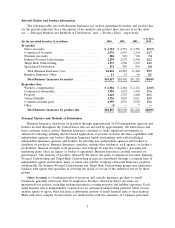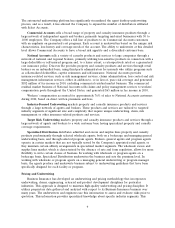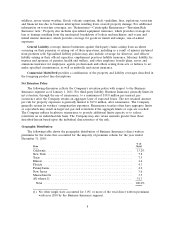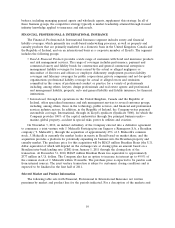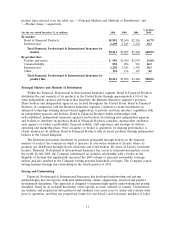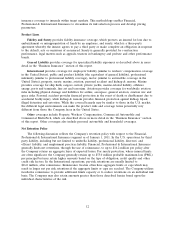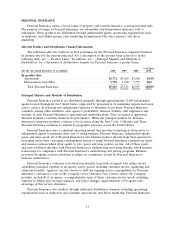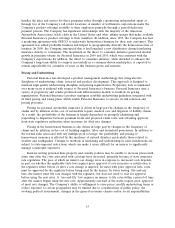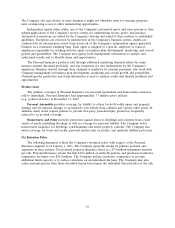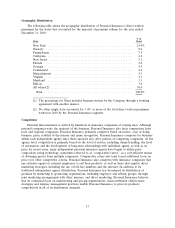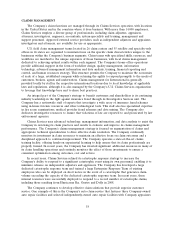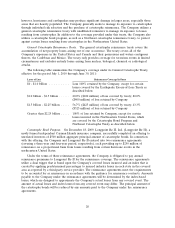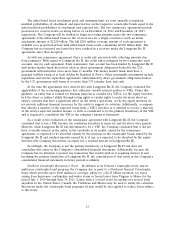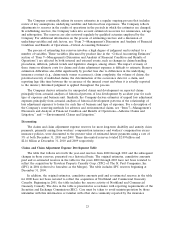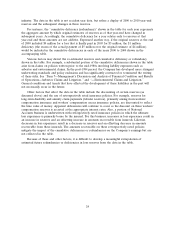Travelers 2010 Annual Report Download - page 27
Download and view the complete annual report
Please find page 27 of the 2010 Travelers annual report below. You can navigate through the pages in the report by either clicking on the pages listed below, or by using the keyword search tool below to find specific information within the annual report.handles the sales and service for these programs either through a sponsoring independent agent or
through two of the Company’s call center locations. A number of well-known corporations make the
Company’s product offerings available to their employees primarily through a payroll deduction
payment process. The Company has significant relationships with the majority of the American
Automobile Association (AAA) clubs in the United States and other affinity groups that make available
Personal Insurance’s product offerings to their members. In addition, since 1995, the Company has had
a marketing agreement with GEICO to underwrite homeowners business for their auto customers. This
agreement has added profitable business and helped to geographically diversify the homeowners line of
business. In 2009, the Company announced that it had launched a new distribution channel marketing
insurance directly to consumers. The investment in the direct to consumer initiative generated modest
growth in premium volume for Personal Insurance in 2009 and 2010, which was consistent with the
Company’s expectations. In addition, the direct to consumer initiative, while intended to enhance the
Company’s long-term ability to compete successfully in a consumer-driven marketplace, is expected to
remain unprofitable for a number of years as this business grows and matures.
Pricing and Underwriting
Personal Insurance has developed a product management methodology that integrates the
disciplines of underwriting, claim, actuarial and product development. This approach is designed to
maintain high quality underwriting discipline and pricing segmentation. Proprietary data accumulated
over many years is analyzed with respect to Personal Insurance’s business. Personal Insurance uses a
variety of proprietary and vendor produced risk differentiation models to facilitate its pricing
segmentation. Personal Insurance’s product managers establish underwriting guidelines integrated with
its filed pricing and rating plans, which enable Personal Insurance to execute its risk selection and
pricing processes.
Pricing for personal automobile insurance is driven in large part by changes in the frequency of
claims and by inflation in the cost of automobile repairs, medical care and litigation of liability claims.
As a result, the profitability of the business is largely dependent on promptly identifying and
responding to disparities between premium levels and projected claim costs, and obtaining approval
from state regulatory authorities when necessary for filed rate changes.
Pricing in the homeowners business is also driven in large part by changes in the frequency of
claims and by inflation in the cost of building supplies, labor and household possessions. In addition to
the normal risks associated with any multiple peril coverage, the profitability and pricing of
homeowners insurance is affected by the incidence of natural disasters, particularly those related to
weather and earthquakes. Changes to methods of marketing and underwriting in some jurisdictions are
subject to state-imposed restrictions, which can make it more difficult for an insurer to significantly
manage catastrophe exposures.
Insurers writing personal lines property and casualty policies may be unable to increase prices until
some time after the costs associated with coverage have increased, primarily because of state insurance
rate regulation. The pace at which an insurer can change rates in response to increased costs depends,
in part, on whether the applicable state law requires prior approval of rate increases or notification to
the regulator either before or after a rate change is imposed. In states with prior approval laws, rates
must be approved by the regulator before being used by the insurer. In states having ‘‘file-and-use’’
laws, the insurer must file rate changes with the regulator, but does not need to wait for approval
before using the new rates. A ‘‘use-and-file’’ law requires an insurer to file rates within a period of time
after the insurer begins using the new rate. Approximately one-half of the states require prior approval
of most rate changes. The Company’s ability or willingness to raise prices, modify underwriting terms or
reduce exposure to certain geographies may be limited due to considerations of public policy, the
evolving political environment, changes in the general economic climate and/or social responsibilities.
15


